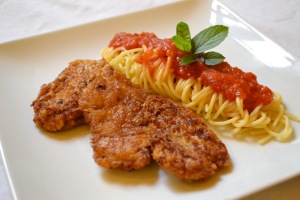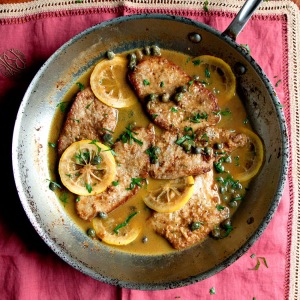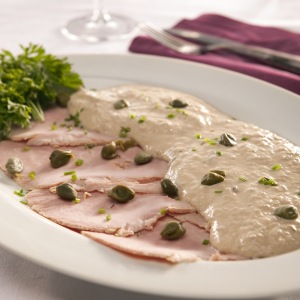
Piccata is a method of preparing food, not The dish as such : meat is sliced, coated, sautéed and served in a sauce. The dish originated in Italy using veal (veal piccata).
In Italy, veal piccata is considered as a “secondo” (second course) and would be served after the pasta course.
Method: the meet is flattened and turned in flour, than turned in a mix of egg and cheese, normally Parmesan. It’s than fried in a frying pan on quite low temperature to avoid the cheese to burn.
Piccata Milanese: the typical Milanese style is to present the meat with a tomato sauce and pasta. As in Italy it’s a so called “secondo” eaten after pasta it’s very often severed without the pasta but with the sauce.
In the United States, the best-known variant is chicken piccata.
A chicken breast is butterflied or sliced along its width. It is flattened with a tenderiser between two pieces of wax paper. It is seasoned and dredged in flour before being browned in butter or olive oil. The sauce is made using the pan drippings. Lemon juice and white wine are added and reduced. Shallots or garlic can be added with capers and slices of lemon. After reduction, butter is stirred in to finish the sauce.
In the United States, it is usually served with a pasta, polenta, or rice.The recipe has a meatless adaptation using seitan (seitan piccata).
Other Italian veal dishes;

Veal scaloppine: Scaloppine (plural and diminutive of scaloppa – a small scallop, i.e., a thinly sliced cut of meat) is an Italian dish consisting of thinly sliced meat (most often veal. It’s dredged in wheat flour, sautéed, then heated and served with a tomato-, or wine-sauce; or piccata, which denotes a caper and lemon sauce.

Vitello Tonnato: is a Piedmontese dish of cold, sliced veal covered with a creamy, mayonnaise-like sauce that has the base of tunafish. It is served chilled or at room temperature, generally in the summertime, as the main course of an Italian meal or as “an exceedingly elegant antipasto for an elaborate dinner”. It is also very popular in Argentina, where it is known as vitel tonné, and considered as a traditional Christmas dish.
It is prepared at least a day or more in advance by braising or simmering a piece of veal from the back leg called Eye Round, which is then cut into thin, individual servings. For the sauce, originally fresh white tuna (in some restaurants canned tuna is used today to reduce cost and preparation time) is simmered until fully cooked in white wine, cider vinegar, white onion and garlic, and then puréed with a mix of olive and vegetable oil and egg yolks in an electric blender or food processor to form a thick mayonnaise-like sauce. For the mayonnaise a variety of seasonings can be used, including anchovies, cayenne pepper and lemon juice. The thick, smooth purée is then somewhat thinned with a little water and cooking liquid from the veal and a few capers are stirred in. Some of the sauce is spread out on a serving platter and the cold slices of veal are arranged in a single layer on top. The rest of the sauce is then poured over the veal so that it is, generally, completely covered. The dish is allowed to refrigerate for a period up to 5 days to fully develop the flavour.

Parmigiana: also called parmigiana di melanzane, or melanzane alla parmigianais. An Italian dish made with a shallow or deep-fried sliced aubergine filling, layered with cheese and tomato sauce, then baked. Parmigiana made with a filling of eggplant ( aubergine) is the earliest and still unique Italian version. Other variations may include chicken, veal, or another type of meat cutlet or vegetable filling. The origin of the dish is claimed by both the Southern regions of Campania and Sicily.
The dish consists of a sliced filling, pan fried in oil, layered with tomato sauce and cheese, and baked in an oven. In some versions, the sliced filling is first dipped in beaten eggs and dredged in flour or breadcrumbs before frying. Some recipes use hard grated cheeses such as Parmigiano, while others use softer melting cheeses like mozzarella, or a combination of these.

Saltimbocco: (also saltinbocca, Italian for jumps in the mouth) is a dish made of veal lined or topped with prosciutto and sage or basil. Marinated in wine, oil or saltwater depending on the region or one’s own taste. This dish is also occasionally topped with capers depending on individual taste. Very popular apart Italy also southern Switzerland, Spain and Greece.

A version of this dish is saltimbocca alla Romana (saltimbocca, Roman-style) which consists of veal, prosciuto and sage, rolled-up and cooked in dry white wine and butter. Marsala is sometimes used, but is not preferred as the sweetness is too strong for the delicate veal. Also, sometimes the veal and prosciutto are not rolled-up but left flat. This causes the prosciutto to dry out during the cooking.

Ossobuco: Is a Milanese speciality of cross-cut veal shanks braised with vegetables, white wine and broth. It is often garnished with gremolata and traditionally served with risotto alla milanese.
There are two types of ossobuco: a modern version that has tomatoes and the original version which does not. The older version, ossobuco in bianco, is flavoured with cinnamon, bay leaf and gremolata. The modern and more popular recipe includes tomatoes, carrots, celery and onions. Gremolata is optional. Veal is the traditional meat used for Ossobuco other meats such as pork may be used.
Ossobuco or osso buco is Italian for “bone with a hole” (osso bone, buco hole), a reference to the marrow hole at the centre of the cross-cut veal shank. In the local Western Lombard Milanese dialect, this dish’s name is oss bus.
Ossobuco was first attested in the late 19th century. It may have been a farmhouse dish or perhaps it was an invention of an osteria, a neighborhood restaurant of Milano.
The dish’s primary ingredient, veal shank, is common, relatively cheap and flavorful. Although tough, braising makes it tender. The cut traditionally used for this dish comes from the top of the shank which has a higher proportion of bone to meat than other meaty cuts of veal. The shank is then cross-cut into sections about 3 cm thick.
Although recipes vary, most start by browning the veal shanks in butter after dredging them in flour, while others recommend vegetable oil or lard. The braising liquid is usually a combination of white wine and meat broth flavoured with vegetables.

Carpaccio: Is the international name of a typical Italian dish made with raw meat. The dish was proposed with this name for the first time in Venice, at the time of an exhibition dedicated to Venetian painter Vittore Carpaccio which took place in 1963.
The dish, based on the Piedmont speciality carne cruda all’albese, was invented and popularised by Giuseppe Cipriani, founder of Harry’s Bar in Venice. He originally prepared the dish for the countess Amalia Nani Mocenigo when he learned that the doctors had recommended that she eat raw meat.[3] The dish was named carpaccio after Vittore Carpaccio, the Venetian painter known for the characteristic red and white tones of his work.
The typical Piedmont carpaccio is made with very thin slices of beef placed on a dish with lemon, olive oil, and shavings of white truffle or Parmesan cheese, and can be topped with arugula.
The meat typically used for carpaccio is beef sirloin. Since this dish is served raw, the meat must be fresh. Less commonly, reflecting Piedmont tradition, carpaccio can also be made with minced meat and garlic, called “carne cruda”.

Cotoletta: (Italian pronunciation: [kotoˈletta]; from costoletta = “little rib”, because of the rib that remains attached to the meat during and after the cooking) is an Italian word for veal breaded cutlet.
Various breaded meat dishes prepared in Latin America were inspired by the cotoletta and are known as milanesa. In South America, ‘Milanesa a la napolitana’ is made similar to the cotoletta with a preparation of cheese and tomato.

Cotoletta alla milanese: (milanese after its place of origin, Milan) is a fried cutlet similar to Wiener Schnitzel, but cooked “bone-in”. It is fried in clarified butter only and traditionally uses exclusively milk-fed veal.

Cotoletta a orecchio di elefante: (“elephant ear cutlet”) is another type of milanese, launched in recent years by trendy Milanese restaurants. This version uses a thinner but larger cut of meat, and is deboned and tenderized prior to frying, similarly to the American preparation of breaded pork tenderloin and chicken fried steak. This is the most common cotoletta eaten in Italy in everyday life because it is easy and fast to prepare. In the typical osteria in Milan the first version is much more common.
Cotoletta alla palermitana: (palermitana because it takes origin from Palermo, Sicily) is similar to a milanese but the veal is brushed with lard or olive oil instead of butter, and then grilled instead of being deep fried. The breadcrumb is very often mixed with oregano and/or Parmesan cheese, and it can be put on the grill upon a leaf of lemon that gives it a particular Sicilian scent. This cutlet is the only one among its “sisters” (tonkatsu and American style breaded meat, etc.) that does not have eggs in its breading.
this looks is absolutely delicious!!
LikeLike
Hi, thanks for your comments. If you klick on the menu in the right upper corner you will find more recipes.
LikeLike